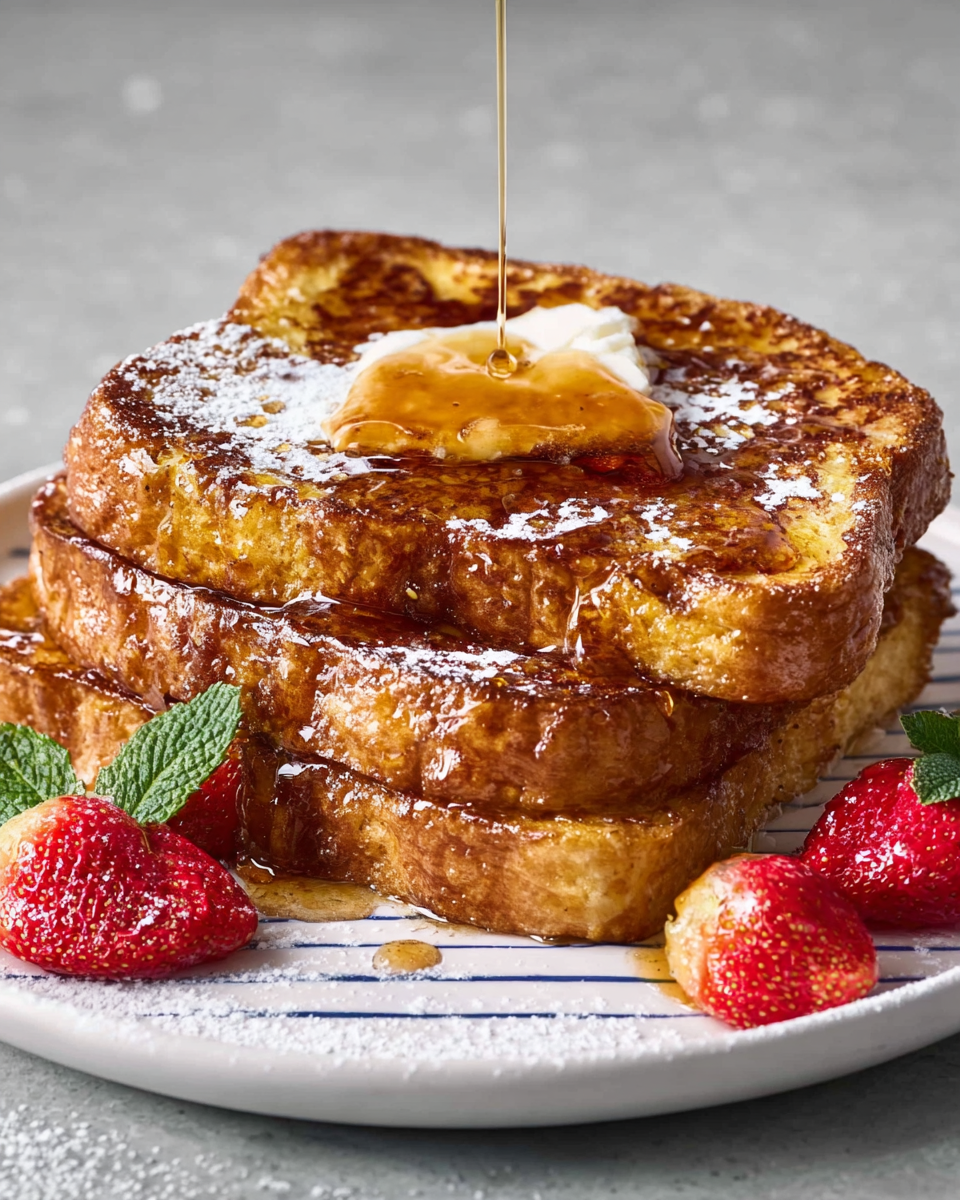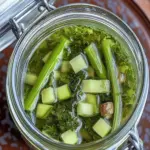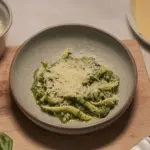The beauty of French Toast lies in its simplicity — soft, rich slices of bread soaked in a lightly sweetened vanilla-cinnamon custard, then pan-fried to golden perfection. This version, inspired by traditional French techniques, uses buttery brioche or challah for an extra pillowy interior. Perfect for weekend mornings or holiday brunches, this French Toast is endlessly customizable. Top with fresh berries, a pat of butter, powdered sugar, or a generous drizzle of warm maple syrup. It’s a guaranteed crowd-pleaser and an easy way to transform day-old bread into something magical and memorable.
Full recipe:
Ingredients:
-
4 large eggs
-
1 cup whole milk
-
2 tablespoons granulated sugar
-
1 teaspoon ground cinnamon
-
1 teaspoon vanilla extract
-
1/4 teaspoon salt
-
8 slices day-old brioche or challah (3/4-inch thick)
-
2 tablespoons unsalted butter, divided
-
Maple syrup, for serving
-
Powdered sugar, for garnish (optional)
Directions:
-
In a large mixing bowl, whisk together the eggs, milk, sugar, cinnamon, vanilla, and salt until smooth and fully combined.
-
Arrange the bread slices in a shallow dish or rimmed baking sheet. Pour the custard mixture over the bread and let it soak for 2 minutes. Flip the slices and soak the other side for 2 more minutes.
-
Heat 1 tablespoon butter in a large skillet or griddle over medium heat until melted and foamy.
-
Add 4 slices of the soaked bread and cook for 3 to 4 minutes per side, or until golden brown and cooked through.
-
Repeat with remaining butter and bread slices.
-
Serve hot with maple syrup and a sprinkle of powdered sugar if desired.
Prep Time: 5 minutes | Cooking Time: 10 minutes | Total Time: 15 minutes
Kcal: 290 kcal | Servings: 4 servings (2 slices per person)
A Timeless Favorite: The Story of Classic French Toast
French Toast, or pain perdu as it’s called in France, translates to “lost bread,” referring to the traditional use of stale or day-old bread that might otherwise be thrown away. This dish has a rich history tracing back centuries, with early versions appearing in ancient Roman cookbooks. Over time, it evolved across Europe, and eventually made its way into American breakfast culture, where it became the indulgent, custard-soaked staple we know and love today.
Though the name suggests French origins, almost every culture has its version of bread soaked in eggs and cooked to golden brown perfection. What sets French Toast apart in American kitchens is its use of enriched breads like brioche and challah, and the addition of cinnamon, vanilla, and often a touch of sugar in the soaking custard.
Why This French Toast Recipe Stands Out
This particular French Toast recipe offers a flawless balance of texture and flavor. The outside becomes crisp and golden in the pan, while the inside stays pillowy and custardy. Unlike versions that rely heavily on cream or butter, this one keeps the ingredients simple — eggs, milk, cinnamon, vanilla, and bread — without sacrificing richness or depth.
A key feature of this method is the use of thick-cut, slightly stale bread. Fresh bread doesn’t absorb custard well and can lead to sogginess. By letting the bread sit for a day, you allow it to soak up the custard without falling apart. Plus, using brioche or challah gives it a naturally sweet, buttery flavor that doesn’t need much adornment.
The Nutritional Edge and Customization Benefits
While French Toast is often seen as indulgent, this version can be surprisingly balanced. Each serving (roughly 2 slices) comes in at around 290 kcal, and you get a solid source of protein from the eggs and milk. If you’re looking for healthier swaps, you can use whole grain bread or plant-based milk alternatives like oat or almond milk, and you can control the sugar content with ease.
Want to make it dairy-free or vegan? Use flax eggs and your favorite dairy-free milk. Craving a high-protein version? Add a scoop of protein powder to the custard mix or use Greek yogurt on top instead of syrup. The base recipe is incredibly forgiving and adaptable to your dietary needs or seasonal flavor cravings.
Perfect for Any Occasion
French Toast is not just for weekends or holidays. Its simple ingredients and quick prep time make it suitable for weekday breakfasts, too. For those with busy mornings, the custard-soaked slices can even be prepped in advance and stored in the refrigerator overnight. The next morning, all you need is a hot skillet and a few minutes to cook.
You can also double or triple the recipe to feed a crowd. Hosting brunch? Serve French Toast with fresh berries, whipped cream, and warm syrup. Looking to impress a partner? Make a romantic breakfast in bed with a dusting of powdered sugar and a side of espresso.
Expert Tips for Flawless French Toast
If you’re aiming for restaurant-quality French Toast at home, here are a few insider tips that make all the difference:
- Use Day-Old Bread: Slightly stale bread holds its shape and absorbs the custard better than fresh bread. Brioche, challah, and Texas toast are ideal choices.
- Balance Your Custard: You don’t need heavy cream — whole milk works beautifully. Too much liquid and not enough egg can make the toast soggy and rubbery.
- Preheat Your Pan: Make sure your skillet or griddle is fully heated before adding the bread. This ensures a beautifully crisp exterior.
- Don’t Overcrowd the Pan: Cook slices in batches if necessary. Overcrowding reduces the pan’s heat and results in uneven browning.
- Let It Rest: After cooking, give the French Toast a minute to rest on a wire rack. This prevents sogginess caused by steam buildup on a plate.
Versatility in Flavors and Toppings
French Toast is one of the most versatile dishes when it comes to customization. You can make it sweet or savory, simple or decadent.
For sweet options:
- Add a teaspoon of orange or lemon zest to the custard.
- Mix in a dash of nutmeg with the cinnamon for a deeper flavor.
- Top with caramelized bananas, strawberries, blueberries, or sautéed apples.
For savory twists:
- Skip the sugar and cinnamon, and add salt, pepper, and grated cheese to the custard.
- Serve with bacon, eggs, or smoked salmon on top.
- Drizzle with hot honey or add a fried egg for a satisfying brunch plate.
You can also flavor the custard with almond extract, cardamom, or even a splash of bourbon for a more elevated experience.
The Best Bread Types for French Toast
Choosing the right bread makes or breaks this dish. While you can technically use any bread, certain types produce superior results. Here’s a quick breakdown:
- Brioche: Rich, slightly sweet, and buttery — the gold standard for French Toast.
- Challah: Eggy and soft, perfect for absorbing custard and maintaining structure.
- Texas Toast: Thick, square slices ideal for a classic diner-style version.
- Sourdough: For a tangy twist, this works surprisingly well in savory versions.
- Croissants or Cinnamon Swirl Bread: Decadent and dessert-like, best for special occasions.
Make-Ahead and Freezer-Friendly Tips
One of the biggest advantages of this recipe is that it can be prepped ahead. Soak the bread slices in custard the night before and refrigerate them in a covered dish. In the morning, they’re ready to cook.
You can also cook an entire batch, let the slices cool, and then freeze them. To reheat, pop them in the toaster or oven — they’ll be just as crisp and delicious as freshly made. This makes it ideal for meal prepping or busy family mornings.
Why This French Toast Belongs in Your Recipe Repertoire
It’s budget-friendly, requires no fancy ingredients, and turns simple pantry staples into something luxurious and satisfying. Whether you’re feeding kids, impressing guests, or just treating yourself to a better breakfast, this recipe consistently delivers.
What really sets it apart is its balance — slightly sweet but not cloying, rich yet light, and endlessly adaptable. Plus, it teaches foundational cooking skills like making a custard base and pan-frying evenly, which transfer to other dishes.
Conclusion
Classic French Toast is far more than just a nostalgic breakfast — it’s a technique, a canvas for creativity, and a reliable go-to recipe for any skill level. With its comforting texture, rich flavor, and endless adaptability, this dish embodies the heart of homemade cooking. Whether served simply with syrup or dressed up for brunch, it offers a moment of indulgence that’s easy to create and always rewarding to eat.
Let it become a part of your kitchen story — one slice at a time.






